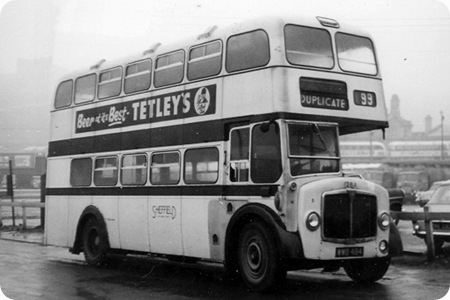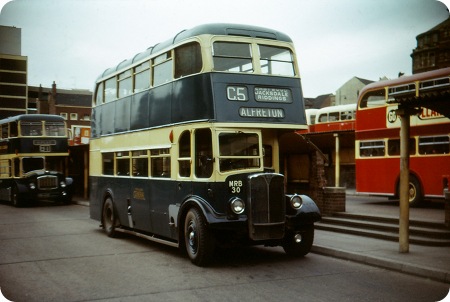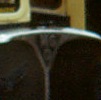LUT – Guy Arab III – KTJ 314 – 408
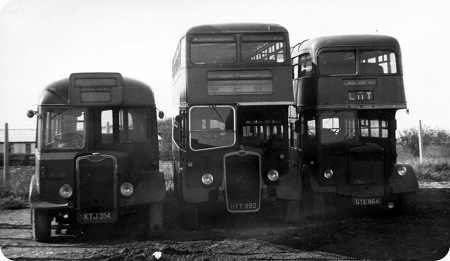
Photograph by ‘unknown’ if you took this photo please go to the copyright page.
Lancashire United Transport
1949
Guy Arab III
Roe B32F
Thanks to Spencer who I think should really be called Sherlock these three have been identified and are here from the ‘Do You Know’ page.
The one on the left is as the above specification. L.U.T. was the largest independent operator in the UK and operated in the South Lancashire area. They were quite diverse with there makes of buses including Atkinson, Foden and Dennis but they did like there Guys. I think but I stand to be corrected they bought the last Guys ever built. If I am wrong let me know, leave a comment.
The bus in the centre was a Western National Omnibus registration 356 HTT fleet no 992 which was a Bristol K5G with an ECW L27/28R built in 1946. I wish I knew more about the Bristol K series so I could write more, can anybody help on that score if so please get in touch.
The bus on the right which I thought was a Leyland Titan is according to Spencer, and I’m not going to argue with him, an L.U.T. Dennis Lance K2 registration GTE 864 fleet no 196 built in 1947 with a Weymann L27/26R body. On further research I have found out that the Dennis Lance K2 had a Gardner 6LW engine which was a 8.4 litre six cylinder diesel.
Just in case you want to know the Dennis Lance K3 had a Dennis 8.0 litre six cylinder diesel and the Lance K4 had a Gardner 5LW 7.0 litre five cylinder diesel. The K4 also had a concealed radiator a touch like the well known Birmingham style, the K 2 and 3 had exposed radiators.
“The last Guy Arabs delivered to a British operator actually went to Chester City and were 1969/70 H registered, LUT bought their last Guy in 1967.
Chris Hough
“Chris is right the last three Guy Arab Vs delivered to Chester Corporation had Northern Counties H41/32F bodies, registrations DFM 345-7H, fleet numbers 45-47.
Spencer
I thought that LUT had either one or two Guy Wufrunians which they didn’t like and sold them on to West Riding Auto?
Geoff
———
They only had one Geoff.
137 were built in total delivered as follows
126 West Riding
2 County Motors
2 Wolverhampton Corporation
2 Accrington Corporation
1 West Wales
1 Bury Corporation
1 Lancashire UnitedSpencer
———
The Bristol K series and the closely associated ECW bodies – a most complex and fascinating subject concerning two absolutely top class and rightly successful manufacturers.
The vehicle shown is one of the very first post-war standard models bought widely by the Tilling Group. It is to the standard dimensions of the time, 26 feet x 7 feet 6 inches. "K5G" denotes the popular 5 cylinder Gardner 7.0 litre engine. The "lowbridge" low height body is of the type with all the upper saloon seats on the nearside, and a sunken offside gangway sadly causing pain and injury to the offside lower deck passengers, especially those who hadn’t seen the little notice "Lower your head when leaving your seat" – a high but necessary price to pay for the often essential reduction in overall height, until the invention of the highly ingenious "Lodekka." A fair few of the early post-war vehicles of this type suffered the indignity of being diverted on loan to London Transport when brand new – this must have gone down very badly with the purchasing operators and their staff – I’ve always held the opinion that it was abominably unfair, and that older vehicles should have been sent to assist with the shortage in the Capital.Chris Youhill
I agree with Chris’s comments re-London getting other operators’ new buses. But think of the poetic justice – London Transport drivers having to do proper gear-changing!
Stephen Ford
I hadn’t really thought of that Stephen but of course you’re right, although we tend to forget after all these years that legions of manual gearbox STs and LTs etc had "only just gone" in the late 1940s. The strange quantity, seventy six, of the new all Leyland PD1s (STD 101 – 176) had also just arrived and would be "sorting the men from the boys" too.
Chris Youhill
It’s a bit off-subject, but I have often suspected that the reason why Nottingham broke with the long AEC tradition, and went for Daimlers as their first orders after the war was the strong preference for pre-selector. I gather AEC could only offer crash-gearbox Regent IIs initially. By 1949 NCT was again taking pre-selector Regent IIIs in large volumes, and the 31 CVD6s of 1948 remained an anomaly.
Stephen Ford
31/01/11
I lived in Clifton, between Swinton and Kearsley until 1948, I know!!!, and remember that LUT had a number of Guy double deckers, which were painted matt grey, had squared-off roof corners and wooden slat seats. At the end of the war one was painted white and had ‘fairy lights’ all round. Just a passing comment.
Jim Moyse
31/01/11 – 20:28
Words/phrases like ‘abominably’ and ‘poetic justice’ are surely a bit strong! Central Division London Transport had barely digested its independents with their multiplicity of makes by 1939. It had updated Green Line and then ordered some 350-odd RT’s which were cut back to 150, and was due to replace much of its fleet by 1942. It lost many vehicles in the Blitz/V bomb attacks (22 complete Tilling STL’s alone at the bombed Croydon Garage, with others damaged) and used up its body float on patched up chassis. It lent out a considerable number of vehicles for most of the latter part of the war, mainly petrol Tilling ST’s, many of which, on return, were condemned (the last didn’t return until 1947). Buses were failing faster than they could be replaced, despite many vehicles being renovated to an excellent standard and other bodies strapped up and maybe even held together by string! What didn’t help was RT production being delayed by a year so that the bodies could be jig-built. Craven-bodied RT’s and SRT’s helped fill gaps. Passengers rocketed, with the maximum number reached in 1949. And it was borrowing a lot of vehicles (mainly coaches) from outsiders. By 1949, nationalised, it was probably a good decision by BTC to quickly allocate new buses, than have a lot of near-scrap vehicles cascaded over a period of months.
It says something for Chiswick that buses designed for a 10 year lifespan lasted over twice that in some cases, even without a rebuild. Some LT ‘scooters’ lasted over 21 years!
And there were still plenty of manual gear change buses in 1949, all 435 Guys, Bristols, (austerity STD’s (they WERE a challenge!), many T’s, pre and post-war, TD’s and some country STL’s on loan.
Many of the drivers would originally have come from independents and be familiar with manual ‘boxes. If any men were sorted out from the boys, I’d say it was the tram drivers who had to convert over to buses!!
Chris Hebbron
01/02/11 – 05:44
Hi Chris – all a harmless bit of banter! On the same subject, I recall a Meccano Magazine cartoon at the time of the vehicle loans to London. It featured a number of buses from various cities, which were sweeping round Trafalgar Square in brilliant sunshine – all except for a Manchester Corporation vehicle which was driving along under its own permanent rain cloud.
Stephen Ford
01/02/11 – 05:44
Many very valid and respected points there Chris H and I must confess that I’d never really studied the "diverted new vehicles" question to such a depth. So I can now see the matter in a more informed way and amend my "abominably unfair" criticism somewhat – but I do still feel though that the intended recipients, both engineering and operating, of the shiny new steeds may well have felt somewhat maligned and I think that I would too. I agree about the tram drivers’ dilemma and I think it nothing short of miraculous that they were able to make the conversion in such large numbers, and those changing to trolleybuses didn’t have a very much easier alternative either !!
Chris Youhill
01/02/11 – 18:52
My comment was light-hearted, too, but I thought a bit a background info would be interesting. I also forgot to mention that the government of the day put a restriction on the number of PSV deliveries, which, in 1948, meant a shortfall of 748 in RT deliveries, which must have been devastating. Although this restriction applied nationally, too, the misery would have been spread out more and the effect less per operator.
It is on record that the diversion of the new Bristol/ECW steeds caused a lot of resentment to intended recipients. As for London Transport, the ever-difficult Met. Police put in their two penn’orth by banning lowbridge buses with their so-called slower dwell-times at bus stops, relenting eventually by restricting them from certain routes!
This meant that, at times, the Bristol K5G’s were put on hilly routes they were unsuitable for. And there were problems with hinged doors and garage capacity! In some ways, welcome though they were, they must have been a mixed blessing to LTE.
If anyone has an interest in reading more, Ken Glazier’s book ‘Routes to Recovery’ is the one to buy.
As for tram drivers in London, when LPTB was formed in 1933, the LCC was the dominant tram operator and there was resentment that local authority staff, some admin, who just happened to be there at that point of their career, were trapped in PSV-land from then on. However, there was no retirement age for such staff and many tram drivers went on for years after the LPTB retirement age! But enough, I’m digressing!
Chris Hebbron
02/02/11 – 06:23
This further information is extremely interesting to me and tells me much that I never knew, even though I was a frequent visitor to Streatham SW16 throughout the War and until around 1995. I well remember the K5Gs on route 137, and I believe that they were not confined to parts of the service but undertook the full very long journey from Highgate Archway Tavern to Crystal Palace. Based no doubt at Victoria (Gillingham Street GM) they probably posed few problems to the drivers there as the Leyland PD1s STD 101 – 176 (or a number of them) were already there. I can imagine the frustration though at having to stop half way up Central Hill at Norwood when already half an hour late at busy times. Happy days for dedicated busmen.
Chris Youhill
02/02/11 – 21:03
Would the Tilling companies concerned have been consulted about the arrangement beforehand or was it a done deal by a higher authority? When the Bristols eventually reached their rightful owners, effectively as second hand vehicles, was there any compensation or had the companies simply been obliged to lend a hand without question?
Chris Barker
07/03/11 – 09:21
After LUT were taken over by GMT, Barton of Chilwell became the largest independent operator who too had a very diverse fleet just like LUT.
Roger Broughton
07/03/11 – 16:03
Chris B – It was a done deal! The Tilling Group had voluntarily sold out to the BTC in September 1948 and almost immediately were told to divert 25% of their new deliveries to LTE, some 200, later reduced to 190 (45 lowbridge). The order annoyed the operators, who felt that LTE had brought the shortage on itself by delaying new vehicle production by insisting the RT family bodies be jig-built.
The first Bristols came in December 1948 and the last went in June 1950.
Most other non-Tilling buses which helped out were single-deckers, although my posting about the Thorneycroft Daring mentioned it was one exception. Others were three new Daimler/Brush CVG6’s from Maidstone Corporation and, from Leeds Corporation, 17 pre-war AEC Regents/Roe (with one Weymann) with pre-selective gearboxes (Leeds STL’s)!
Unlike the other surplus austerity buses, which went all over the place, but were banned from going to a BET company, when the 29 austerity Bristols were then ready to leave LTE, the word was put out to BTC in advance, so that the ex-Tilling companies could prepare for their transfer.
Chris Hebbron
10/03/11 – 07:41
Referring to the comment by Jim Moyse, I suspect the grey Guy’s were wartime deliveries with utility specification bodies. A trip to most local libraries in South Lancashire should yield a copy of British Bus And Trolleybus Systems number 7, Lancashire United/SLT, which details the whole story.
With regard to the Guy Arab IV’s and V’s of the fifties/sixties, a friend of mine drove these, working out of Swinton depot. He subsequently purchased number 134, 6218 TF, the penultimate open rear platform model, later disposed of, current owner/location unknown.
A peculiarity of the gearbox is that depressing the clutch pedal to it’s full stroke before selecting first gear results in the the box locking, preventing any attempt to upshift. I can’t remember whether double-declutching released it, or whether it was necessary to stop the vehicle. Apparently something around 75% of pedal travel is all that is required for normal operation.
Phil Meadows
15/03/11 – 16:43
It’s taken me a while to puzzle out Phil’s gearbox lock-up. Pressing the clutch pedal all the way down activates a device called a clutch-stop, which is a transmission brake on the shaft connecting the clutch to the gearbox. This may be useful in counteracting clutch-spin when engaging a gear at rest, but more importantly it can be used to speed up gear-changing. The clutch-stop on Guys was more gentle than on Bristols and Leylands, producing a comfortably fast change rather than a rapid one. But I’ve never heard of a clutch stop locking a gearbox before.
I finally realised that trying to move out of gear with a transmission brake on is exactly like trying to do so with the clutch engaged and the engine stopped. The gearbox input shaft needs to be free to rotate, so you need to lift the clutch pedal slightly to free it off.
Peter Williamson
18/06/11 – 18:31
Just a small point in the original note to this picture. The Dennis Lance K3 certainly had a Dennis power plant, but it was the O6 of 7.58 litres capacity, a four valve per cylinder engine of excellent quality. The 8 litre variant of this engine didn’t appear until the later 1950s. Dennis was the only British manufacturer to design and produce diesel engines with four valve heads, in 5 litre, 5.5 litre, 7.58 litre and 8 litre sizes. The Crossley HOE7 was initially designed as a "four valver" using Saurer concepts, but, when Saurer asked for a royalty payment, the Crossley engine was rapidly redesigned as a "two valver", with disastrous consequences, becoming notorious for its poor performance and unreliability.
Turning to the "London Transport question", a great many London buses were certainly rebuilt in their lifetimes, particularly when Aldenham was up and going. Even some of the older types were given major body overhauls. Many of the six wheeled LT single deck "scooters", which I am old enough to be able to recall having travelled on, on routes 213 and 234, were given major body overhauls by Marshalls of Cambridge around 1949. From the RT type onwards, London buses were designed to be taken apart every five years or so, with chassis and body being sent on separate tracks through Aldenham Works. Each chassis emerging at the far end then took the first available rebuilt body, not the one it went in with. No other operator in the land followed this costly procedure, and the supposed long life of London bus types needs to be balanced against the regular visits to Aldenham. The much vaunted RM only survived for so long in London service because of this rebuilding procedure. The Northern General RMs, which had to rely on standard overhaul methods, were withdrawn around 1980 after a life of some 15 years.
Roger Cox
01/09/11 – 10:55
In Relation to Lancashire United’s Sole Guy Wulfrunian, they actually ordered 3 to be fleet numbers 58-60 in the Post 1959 fleet, but only 58 (802 RTC) was delivered it being unpopular, there is a picture of it shown close to Atherton depot on service 82 on flickr. The remaining order for 2 was changed and materialised as the trusted Guy Arab fleet number 59 and 60.
The Last numbered Guy Arab in the LUT fleet was 290 delivered in 1967 (265-290) In the post 1959 fleet LUT Guy Arabs were
18-27 with Northern counties body
40-49 with Metro Cammell Weymann bodies (40 was rebuilt in 1966 to a front door layout following serious accident on the East Lancs road at Ellenbrook)
50-57 NCME
59 and 60, then 61-80, 103-135 all rear loaders with NCME 136 (6220TF) was the first build front loader NCME
159-170, 186-195, 218-240, 265-290 all NCME
Many an enjoyable day riding on, conducting and driving these buses I worked at LUT Atherton from being 18 in 1977 until it closed on 7th Feb 1998. I still work for First now some 34 years.
Chris Stott
02/09/11 – 11:23
With regard to the loaned Provincial Bristols to L.T.E. if you watch the film starring Jack Warner The Blue Lamp one passes by in the dark in one scene.
Philip Carlton
26/11/12 – 08:39
In the list of Guy Wulfrunian chassis above the total of 137 is correct but missing from the list underneath are the two demonstrators, 7800 DA and 8072 DA. I believe that they were both ultimately sold to West Riding for spares. Sold to West Riding for service were the LUT, West Wales, and two County examples – one of the ex-County ones is now preserved. Despite their illogical layout, both the Accrington ones saw further service. I have read that they initially went to Ronsway of Hemel Hempstead, but one finished up with Byley Garage in Cheshire – and they did use it, as I saw it on the road on one occasion. The Bury one was sold on to a succession of Welsh independents before ending up with Berresford’s at Cheddleton – I’m not sure whether or not it was actually used there. Later it was placed in storage behind GMT’s Hyde Road depot as a prelude to a proposed preservation, but for reasons which now escape me, this ultimately didn’t come to pass.
The two Wolverhampton examples failed to sell to any subsequent operator.
Until I read Chris’s post above I had quite forgotten that LUT 59 & 60 had been intended to be Wulfrunians. The order was presumably altered before even No.58 had been constructed.
David Call
26/11/12 – 10:28
Talking of Wulfrunians, coincidentally I have just been re-reading David Harvey’s fascinating book ‘The Forgotten Double Deckers’, in which he states that Rotherham and Belfast had ordered three and one Wulfrunians respectively but cancelled their orders very quickly when they began to hear bad news about the model. The two cancelled LUT buses would have been rear entrance types like Accrington’s pair, as would even more incredibly a pair provisionally ordered by Todmorden J.O.C – a staunch and very traditional Leyland customer. The mind just boggles at the thought of Todmorden Wulfrunians climbing up to Mankinholes!
John Stringer
27/11/12 – 07:32
I recall that West Riding ordered a batch of single deck Wulfrunians but changed the order in favour of double deckers. What would they have looked like? I was interested in the information about potential customers who suddenly got cold feet.
Philip Carlton
29/11/12 – 07:32
I imagine that a single-deck Wulfrunian would have worked a lot better than the double-deck ones did, owing to the reduction in weight. As to what it would have looked like, I think that would depend on whether Roe were allowed to design it themselves or had more nonsense imposed on them by Park Royal. It’s a fascinating thought, as there were no low-floor single deckers around at all at that point.
Peter Williamson
29/11/12 – 11:05
Wasn’t the Guy Victory export chassis to some extent a version of a single deck Wulfrunian? I believe it had a front mounted engine, semi-automatic transmission, disc brakes and optional air suspension.
John Stringer
03/11/14 – 06:24
I can see that this thread is almost two years old … but regarding LUT Wulfrunians. I always thought that nos 58 AND 59 left the bodyworker en-route to Atherton BUT No 59 was written off in a road traffic accident before arriving in Howe Bridge?
Iain H
07/11/14 – 15:43
Iain H, Please refer to Bus lists on the web and can you see any NCME body numbers for 58 & 59 if they were built as Wulfrinians?
No, they were built as standard 30 rear entrance Arab IV’s
Mike N
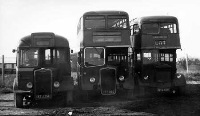 Vehicle reminder shot for this posting
Vehicle reminder shot for this posting
07/09/20 – 06:11
Regarding the Accrington Wulfrunians they were in sense Guy Arabs having manual gearboxes instead of a semi automatic one.
Why Accrington specified rear entrance is probably due to the council committee at the time (look at 14,15 and 16) these came as rear entrances
F. Atkinson
08/09/20 – 06:21
Re Accrington’s rear entrance Wulfrunians, see my article Days out with Martin Hannett on this site.
Phil Blinkhorn
Quick links to the - Comments Page - Contact Page - Home Page
